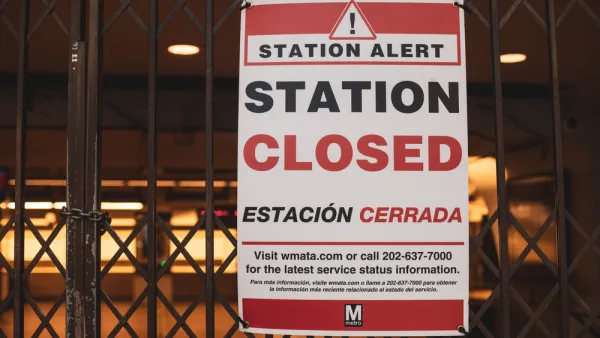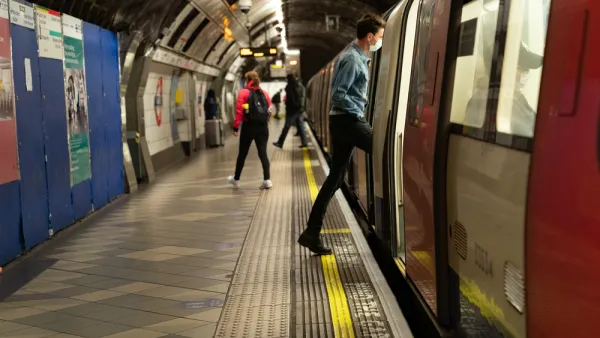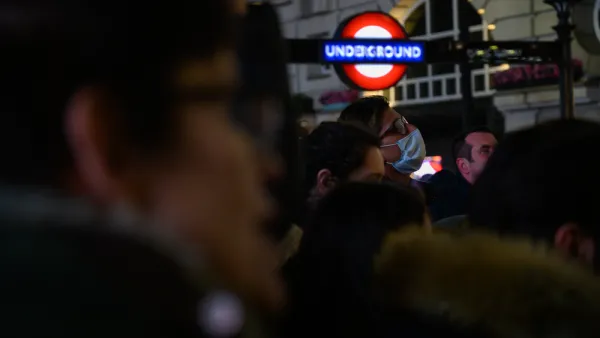Recent analysis by TransitCenter quantifies the effects of the pandemic for the 150 largest U.S. transit systems.

TransitCenter presents data on the operations of public transit agencies during the COVID-19 pandemic—finding ongoing evidence of sweeping service reductions in almost every part of the country. Some cuts have been deeper than others, however, as transit agencies have delt with declining ridership (and the farebox revenues that come along with riders)—whether due to disrupted commute patterns or stay-at-home orders—and the public health risks posed to operators.
TransitCenter analyzed data from National Transit Database monthly data to provide the following summariy of the state of public transit in the United States at the conclusion of the pandemic year, 2020.
Of the 150 largest transit agencies, about one in six were providing less than 75% of their pre-pandemic service hours in December 2020. Meanwhile, nearly a quarter were running between 90 and 100% of pre-pandemic service, and 27 agencies were running more service than they were before the pandemic as part of providing socially distanced transit.
Among those aggregated figures, TransitCenter also notes big differences between the largest agencies. While some have been able to restore most of the service cut in spring of 2020, some have struggled to restore service. The San Francisco Municipal Transportation Agency (SFMTA) has dealt with technical challenges restoring Muni Metro service, for example. The Maryland Transit Administration was operating just 66 percent of its pre-pandemic capacity in December, according to the article (after stopping short of cutting service even deeper). At the other end of the spectrum, Phoenix is operating more transit service than before the pandemic.
Breaking down the data by mode, TransitCenter reports that service has been cut most deeply for commuter rail—indicating one potential outcome of the long-term effects of fiscal stress and migration patterns of the pandemic.
FULL STORY: How Much Service Are Transit Agencies Running During the Pandemic?

National Parks Layoffs Will Cause Communities to Lose Billions
Thousands of essential park workers were laid off this week, just before the busy spring break season.

Retro-silient?: America’s First “Eco-burb,” The Woodlands Turns 50
A master-planned community north of Houston offers lessons on green infrastructure and resilient design, but falls short of its founder’s lofty affordability and walkability goals.

Delivering for America Plan Will Downgrade Mail Service in at Least 49.5 Percent of Zip Codes
Republican and Democrat lawmakers criticize the plan for its disproportionate negative impact on rural communities.

Test News Post 1
This is a summary

Test News Headline 46
Test for the image on the front page.

Balancing Bombs and Butterflies: How the National Guard Protects a Rare Species
The National Guard at Fort Indiantown Gap uses GIS technology and land management strategies to balance military training with conservation efforts, ensuring the survival of the rare eastern regal fritillary butterfly.
Urban Design for Planners 1: Software Tools
This six-course series explores essential urban design concepts using open source software and equips planners with the tools they need to participate fully in the urban design process.
Planning for Universal Design
Learn the tools for implementing Universal Design in planning regulations.
EMC Planning Group, Inc.
Planetizen
Planetizen
Mpact (formerly Rail~Volution)
Great Falls Development Authority, Inc.
HUDs Office of Policy Development and Research
NYU Wagner Graduate School of Public Service





























